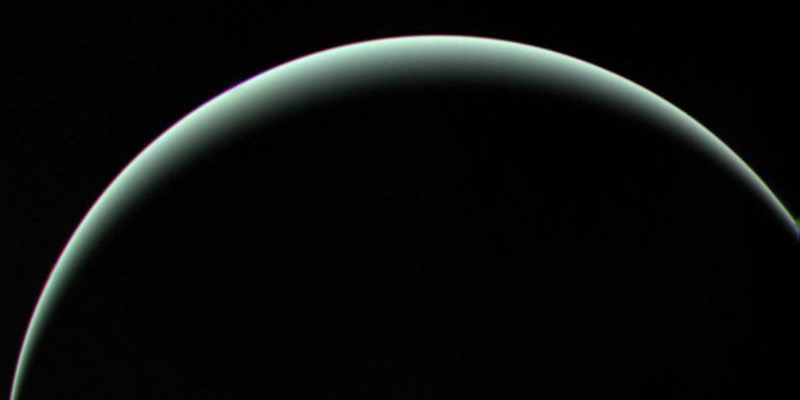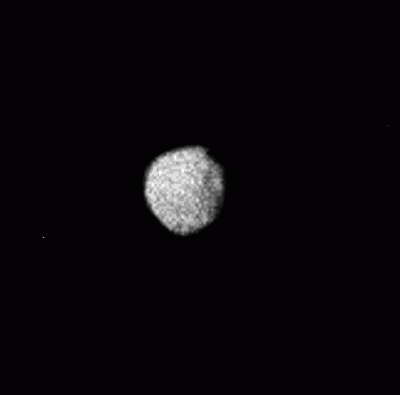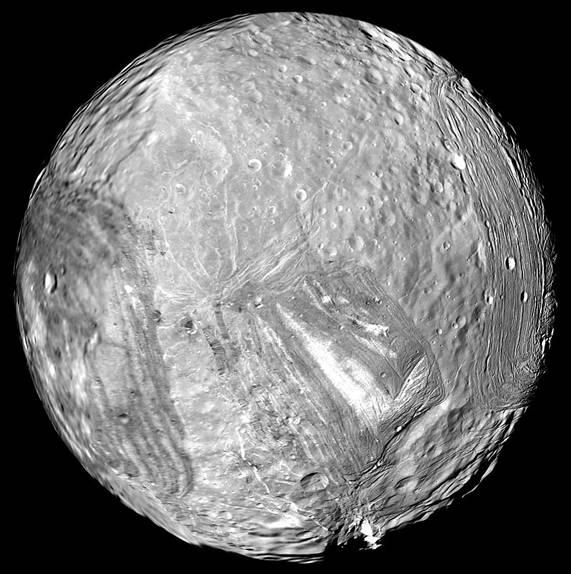

Farewell, Uranus! Image via NASA/ JPL.
January 24, 1986. On this date, the Voyager 2 spacecraft came within 50,640 miles (81,500 km) of the cloud tops of the planet Uranus. It was the closest – and only – visit by a human-made craft to this planet. During its closest approach, and in the weeks before and after, Voyager 2 transmitted a treasure trove of scientific data that indelibly changed our view of this enigmatic, distant world.
Many remarkable discoveries came from this mission. Data from Voyager 2 revealed that a Uranian day is just 17 hours and 14 minutes long. It showed that Uranus’ atmosphere is very similar to that of the other gas giants, composed mainly of hydrogen and helium. Below it lay water, ammonia and methane ices.

The mostly featureless light green-blue disk of Uranus was imaged by Voyager 2 on January 14, 1986, when it was about 7.8 million miles (12.6 million km) from the planet. Image via NASA/ JPL.
Scientists knew, from telescopic observations made from Earth, that Uranus’ rotation axis was tilted at 98 degrees. In other words, the planet’s equator lies almost perpendicular to the plane of its orbit! Scientists think the planet was tipped on its side by a collision with a planet-sized object, early in the solar system’s history.
As a result, Uranus has, perhaps, the most interesting seasonal patterns in the solar system. Read more: What are the seasons like on Uranus?
Voyager 2 revealed that Uranus has a bizarre magnetic field. The planet’s magnetic field is also tilted, at 59 degrees from Uranus’ axis of rotation. This arrangement creates a non-uniform magnetic field for Uranus that can vary by up to 10 times!

A diagram of Uranus’ magnetic field based on data from Voyager 2. It’s tilted, at 59 degrees, from the axis of rotation. S and N are magnetic south and north poles. Image via Ruslik0/ Wikimedia Commons.
Voyager 2 found that Uranus has radiation belts similar in intensity to those of Saturn. Earth also has radiation belts, with the two main ones known as the Van Allen belts.
Initially, 10 new moons were discovered in the data sent back by Voyager 2, for a total of 15 moons known at the time. In 1999, additional analysis of Voyager 2 data revealed an 11th moon. Today, we know of 27 moons orbiting Uranus.
Among the newly discovered moons was Puck, just 100 miles (160 km) in diameter, with a gray heavily cratered surface.
Voyager 2 also imaged the Uranian moons we already knew, revealing their amazing geology.
The last Uranian moon discovered before Voyager 2’s arrival was Miranda, found by Gerard Kuiper at McDonald Observatory in Texas in 1948. Thanks to Voyager 2, we saw Miranda much more clearly. In fact, it picked up the nickname of Frankenstein moon because its strange haphazard appearance.

Puck, one of the moons of Uranus discovered by Voyager 2. This image was taken on January 24, 1986, at a distance of about 306,300 miles (500,000 km). Image via NASA/ JPL.

Observe Miranda’s sharp and diverse features, which gave it the nickname Frankenstein moon. Image via NASA/ JPL.
By the time of Voyager 2’s visit, it had already been discovered from Earth that Uranus has rings. Voyager 2 surveyed Uranus’ rings and discovered two new ones, bringing the total number of rings to 11. Today, there are 13 known rings.

A backlit view of the Uranian ring system shows fine particles distributed through the rings. This image was taken just 147,000 miles (240,000 km) away from the planet. Image via NASA/ JPL.
And so Voyager 2 vastly increased our knowledge of Uranus – and then left this world behind for one final rendezvous, with Neptune in August 1989, before heading out of the solar system. In December 2018, NASA announced that Voyager 2 had entered interstellar space. Forty-three years after it launched from Cape Canaveral in 1977, the spacecraft is almost 11.5 billion miles (18.5 billion km) from home.
[youtube https://www.youtube.com/watch?v=OxOilgsZduk&w=800&h=450]By the way, it was the famous astronomer William Herschel who discovered Uranus. It was the first planet to be discovered with a telescope, the first to be added to the group of bright planets – Mercury, Venus, Mars, Jupiter, Saturn – known since antiquity.
Uranus is the third-largest planet in our solar system. It could contain 63 Earths. But it isn’t a bright planet because it’s very far away, about 1.9 billion miles (3 billion km) from the sun, or 20 times the Earth-sun distance.
Bottom line: Voyager 2’s closest encounter with Uranus happened on January 24, 1986. It’s the only spacecraft to have ever visited this frigid world in the outer solar system, leaving a rich legacy of information that has forever changed our view of that pale green-blue planet.
Source:
https://earthsky.org/space/voyager-2-meets-uranus-jan-24-1986